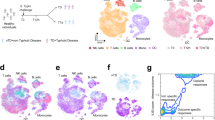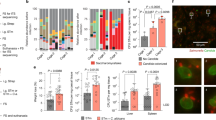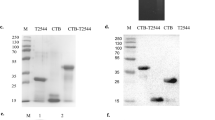Abstract
The time course and nature of mucosal damage induced by two human strains of Salmonella typhimurium (TML and W118)in rabbit ileal loops was assessed by scanning and electron microscopy. Fluid secretion was measured by ml fluid accumulated per cm rabbit ileal loop.
Salmonella-induced fluid secretion (>0.5ml/cm) occurred in the presence or absence of gross mucosal damage. Neither strain induced mucosal ulceration. When damage did occur it involved shortening of villi by loss of tip regions invaded by Salmonellae with concomitant reforming of an intact mucosal surface. Intestinal crypts were not invaded.
Immediately proceeding the onset of fluid secretion, marked infiltration of the mucosa with polymorphonuclear leukocytes was seen. This revives an earlier suggestion that interaction between invading Salmonellae and acute inflammatory cells may be an important factor in the initiation of fluid secretion.
Brush border invasion by Salmonellae, which was maximal in the first 4h after infection, cannot be the immediate cause of fluid secretion, as the latter occurred 2h after initial invasion.
Similar content being viewed by others
Log in or create a free account to read this content
Gain free access to this article, as well as selected content from this journal and more on nature.com
or
Author information
Authors and Affiliations
Rights and permissions
About this article
Cite this article
Wallis, T., Starkey, W., Stephen, J. et al. THE NATURE & ROLE OF MUCOSAL DAMAGE IN RELATION TO SALMONELLA TYPHIMURIUM-INDUCED FLUID SECRETION IN THE RABBIT ILEUM. Pediatr Res 20, 691 (1986). https://doi.org/10.1203/00006450-198607000-00034
Issue date:
DOI: https://doi.org/10.1203/00006450-198607000-00034



